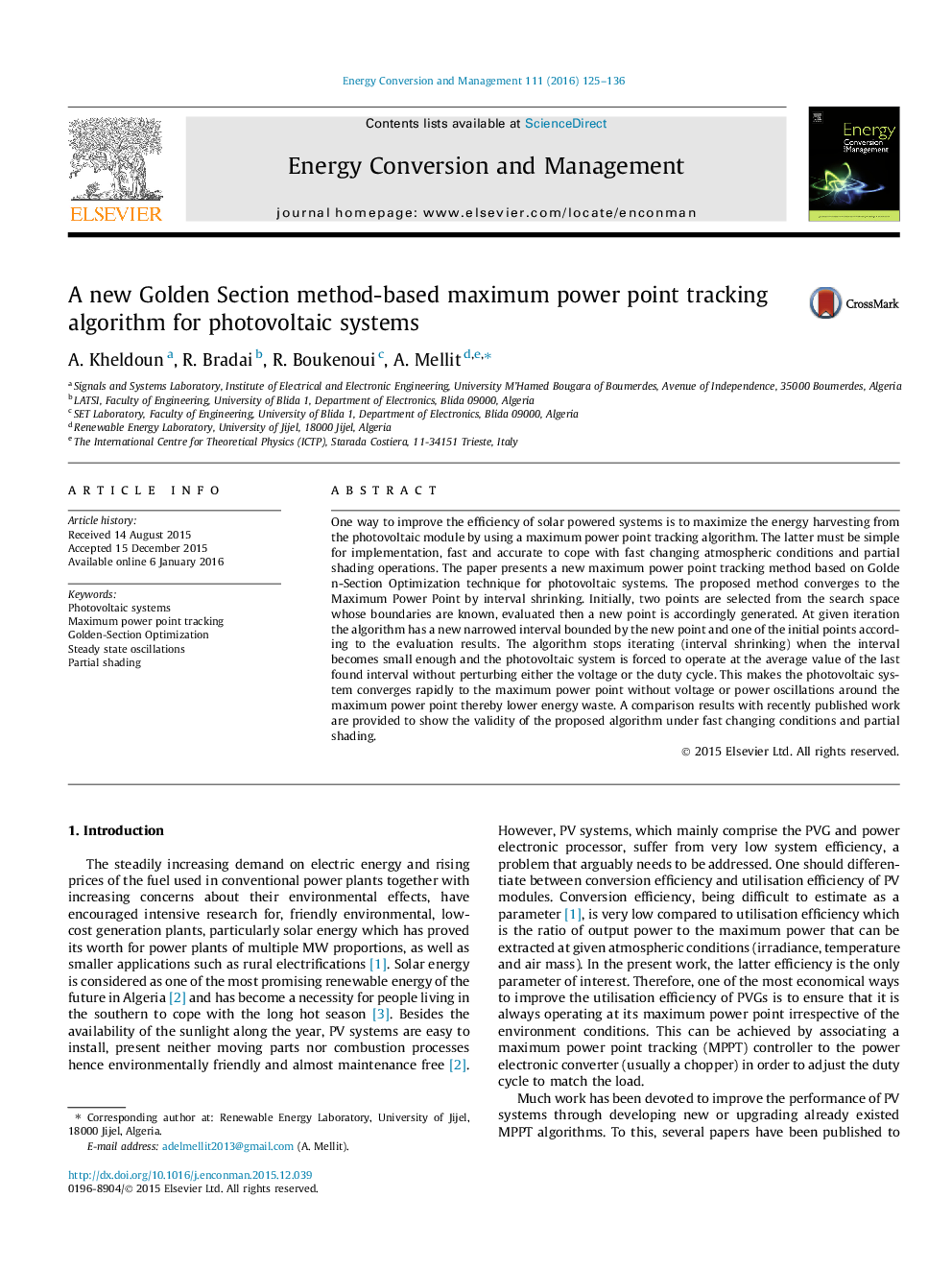| کد مقاله | کد نشریه | سال انتشار | مقاله انگلیسی | نسخه تمام متن |
|---|---|---|---|---|
| 771514 | 1462851 | 2016 | 12 صفحه PDF | دانلود رایگان |
کلیدواژهها
1.مقدمه
2. مدلسازی سیستم فوتوولتائی
شکل 1. سیستم فوتوولتئی با یک مبدل باک DC-DC.
1.2. المان فوتوولتائی ایدهآل
شکل 2. مدار معادل یک المان فوتوولتائی ایدهآل و عملی.
2.2. مدلسازی ماژول فوتوولتائی
شکل 3. مدار معادل ماژول فوتوولتائی.
جدول 1. مشخصات KC200GT در شرایط استاندارد تست (AM 1.5، G=1 کیلووات بر مترمربع، T=25 درجۀ سلسیوس)
3.2. مشخصات ماژول فوتوولتائی
شکل 4. مسشخصات P-V ماژول فوتوولتائی KC200GT در G و T مختلف.
4.2. مشخصات ماژول فوتوولتائی با سایهافتادگی جزئی
شکل 5. مشخصات آرایۀ فوتوولتائی تحت سایهافتادگی جزئی، (الف) منحنی I-V، و (ب) منحنی P-V.
3. تعقیب نقطۀ حداکثر توان با استفاده از روش بهینهسازی بخش طلایی
1.3. روش بهینهسازی بخش طلایی (GSO)
2.3. تعقیب نقطۀ حداکثر توان مبتنی بر GSO
شکل 6. نمودار گردشی روش MPPT ارائه شدۀ مبتنی بر GSO.
4. نتایج و بحث
شکل 7. برنامۀ متلب/سیمولینک سیستم توسعه یافتۀ MPPT مبتنی بر GSO: (الف) PVG+ مبدل باک DC-DC، (ب) مدار کنترل (GSO-MPPT + PI + مدار PWM) و(ج) اندازهگیریها.
جدول 2. مقادیر اجزای مبدل DC-DC
1.4. تست تحت STC
شکل 8. فرایند جستجوی نقطۀ حداکثر توان با استفاده از MPPT مبتنی بر GSO : (الف) ولتاژ مرجع، و (ب) ولتاژهای فوتوولتائی و بار.
شکل 9. تعقیب نقطۀ حداکثر توان: (الف) شکلموجهای جریان، و (ب) توان خروجی صفحۀ فوتوولتائی.
2.4. تست تحت تابش متغیر
شکل 10. نتایج تغییر سطح تابش: (الف) شکلموجهای ولتاژ، و (ب) توان خروجی صفحۀ فوتوولتائی.
3.4. تست تحت دمای متغیر
شکل 11. نتایج تغییر دما: (الف) شکلموجهای ولتاژ، و (ب) توان خروجی صفحۀ فوتوولتائی.
4.4. تستهای تحت سایهافتادگی جزئی
1.4.4. تست 1
شکل 12. عملکرد تحت سایهافتادگی جزئی، (الف) شکل موجهای ولتاژ، و (ب) توان خروجی صفحۀ فوتوولتائی.
2.4.4. تست 2
شکل 13. عملکرد تحت سایهافتادگی جزئی، تست 2 (الف) شکلموجهای ولتاژ، و (ب) توان خروجی صفحۀ فوتوولتائی.
5.4. مقایسه با روشهای دیگر
1.5.4. تعقیب ایستا
جدول 3. پارامترهای چهار روش MPPT.
شکل 14. توان خروجی فوتوولتائی روش های مقایسه شده در STD.
2.5.4. تعقیب دینامیکی
شکل 15. نتایج تعقیب دینامیکی: (الف) شکلموجهای توان، و (ب) خطای تعقیب.
جدول 4. راندمان تعقیب دینامیکی و سطح پیچیدگی
5. نتیجهگیری و کار آینده
• A new maximum power point tracking method for photovoltaic system is proposed.
• The method shows excellent new maximum power point tracking capability.
• Golden Section Optimization is able to handle the partial shading condition.
One way to improve the efficiency of solar powered systems is to maximize the energy harvesting from the photovoltaic module by using a maximum power point tracking algorithm. The latter must be simple for implementation, fast and accurate to cope with fast changing atmospheric conditions and partial shading operations. The paper presents a new maximum power point tracking method based on Golden-Section Optimization technique for photovoltaic systems. The proposed method converges to the Maximum Power Point by interval shrinking. Initially, two points are selected from the search space whose boundaries are known, evaluated then a new point is accordingly generated. At given iteration the algorithm has a new narrowed interval bounded by the new point and one of the initial points according to the evaluation results. The algorithm stops iterating (interval shrinking) when the interval becomes small enough and the photovoltaic system is forced to operate at the average value of the last found interval without perturbing either the voltage or the duty cycle. This makes the photovoltaic system converges rapidly to the maximum power point without voltage or power oscillations around the maximum power point thereby lower energy waste. A comparison results with recently published work are provided to show the validity of the proposed algorithm under fast changing conditions and partial shading.
Journal: Energy Conversion and Management - Volume 111, 1 March 2016, Pages 125–136
